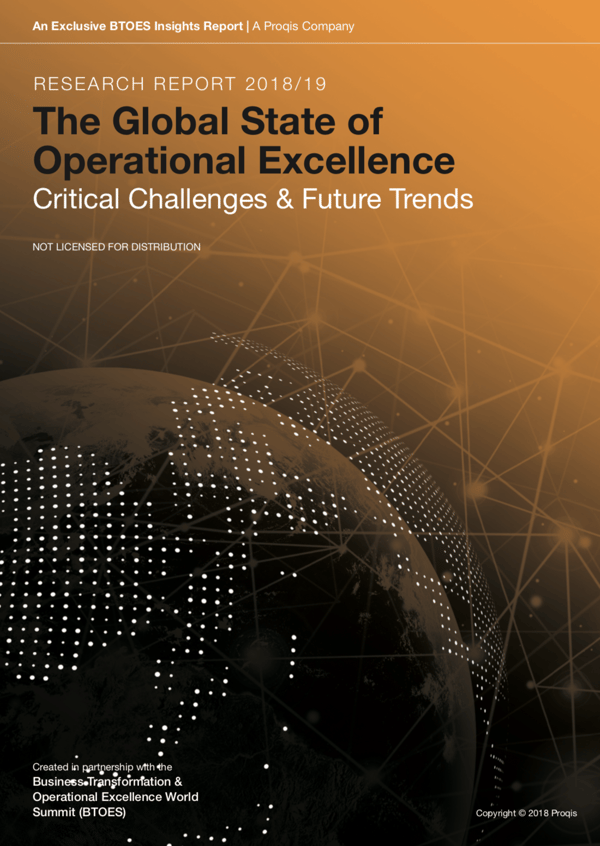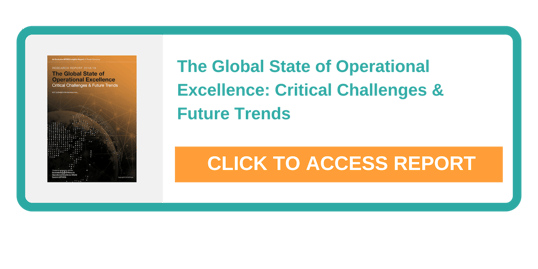










































Lucie Morel has written an article on her interpretation of the Global State of Operational Excellence Survey Report - Critical Challenges & Future Trends - 2018/2019. Click here to download the full Survey Report 2018/19.
The Most Comprehensive Study of Critical Challenges and Future Trends within Operational Excellence
With nearly 1000 respondents, 37 insightful questions, detailed analysis & insights from 40 industry thought leaders, and the BTOES Insights executive team, this 130 page report is recognised as the most comprehensive study of critical challenges and future trends within Operational Excellence, and is considered a key resource for the industry. Areas covered include:
The Critical Operational Excellence Challenges faced by executives.
The Current Scope of Operational Excellence.
How is Operational Excellence success measured?
Key Findings & Roadblocks.
What are executives focusing on over the next 12-18 months?
What have been the greatest developments?
What are the key drivers pushing change in Operational Excellence?
Industry Perspectives.
Small, Medium & Large Corporation Perspectives.
Detail Analysis & Insights from BTOES Insights Executive Team.
Detailed Analysis & Insights from 40 Industry Thought Leaders.
Analysis of key themes, including Cultural Transformation, Customer Delight, Sustaining an Operational Excellence program, Need for end-to-end Business Transformation, Keeping up with new technologies/impact of digitalization and Leadership Buy-in & Understanding.

Complete form to access Report now
 Building an improvement culture, fast and slow
Building an improvement culture, fast and slowAs I started to work on business improvement projects, I found out that it was easy to define the desired change but much harder to implement the change. I observed in most companies some resistance to change due to trust issues. There could be a very strong bond within a team but everyone else in the company was not always well accepted. Like people, organisations have their personality, their mindset and behaviours. I also discovered that as soon as the top leader changed, the culture shift happened.
Culture is every day core values and behaviours of each member of the team in pursuit of the company mission and strategy. It is a shared way of doing things. Operational excellence is all about culture. It is about building an improvement culture where everyone everyday learns and thrives by delivering the best service possible to clients, with empathy, respect and teamwork. Click here to read more Articles on The Global State of Operational Excellence: Critical Challenges & Future Trends - Research Report 2018/19.
As I look back at my very first experience, the CEO was tempted to impose the change to teams rather than leading the way and engaging them in the challenge. If the top leader is not first in line with the teams to challenge the ‘way things are done here’, then there is no point in trying to build an improvement culture. It is not going to happen.

There is not one way to build an improvement culture, or rather a learning culture. I suggest we try and learn with an experiment, using the famous Deming PDCA cycle (Plan Do Check Act) https://deming.org/explore/p-d-s-a

a. PLAN - Start with why
Why do we need to change ? What is our ideal culture ? What is the gap between the current culture and the target one ? Why is it important now ? How do we translate this in terms of Key Performance Indicators ? How will we know we have achieved our goal ?
Before we start changing, we need to be clear about the direction, what the status quo is, why we need to change, what is it that we actually want to change, and what we do not want to change.
It could be powerful to emphasise the good things about the current culture, maybe there are already role models and improvement practices that exhibit a kind of target.
We need to have a compelling vision to share with people. If they see how it can look like to work in a constructive learning culture they may be willing to come on board with us. Advocates, informal leaders can play an active role in shaping the desired culture.
Giving a sense of urgency is a good thing to excite people as long as it is done in a mindful and positive way.
Culture like "the operating system" leads an organization and its activities, shaping the way employees think, work and how they feel. It is recognised than an effective organisational culture has a positive impact on performance. An ineffective culture on the opposite, can have a devastating impact on the company performance.
How would you define your target culture ?
How does the current one look like ?
Is the leader’s main role to develop their people and look after them ?
Is a problem seen as an opportunity for improvement ?
Are problems discussed based on facts, and observations ?
Here are the traits which I would expect in an improvement culture.
However, unless you are a brand new company you will need to take time to identify the status quo before moving on. You may want to look at the following ;
Client centric/ value : focus on delivering value for clients, partners, users, colleagues with minimum waste
Learning: developing people, solving problems
Humanistic: encourage others, shows respect and empathy
Affiliative: enjoys developing relationships with others
On this topic, Human Synergistics has developed an effective tool (the circumplex https://www.humansynergistics.com/Files/HTML5/Circumplex/index.html) to help assess a constructive culture.
Depending on the business context and situation, you may also want to focus on client satisfaction or engagement as performance indicators.

b. DO - Build awareness and a sense of ownership
Some people have strong curiosity, also referred as growth mindset. For them it may be easier to unlearn and learn new habits, they would be curious and enthusiastic about the challenge. For others, with more of a fixed mindset, they need more time and more support to move from the old ways to the news ways of thinking and doing. It can also be uncomfortable for a person who only knows « the control and command » management, to move to a system where they are expected to lead with coaching practices, ‘go and see’, listen, develop people so that they can manage their work themselves, and solve problems.

Understand what you need to unlearn
The tricky part with Culture, is that it means not only acquiring a new set of values, behaviours, habits. It requires to ‘unlearn’ the previous ones. It is easier to learn than unlearn. Unfortunately to build a culture of improvement, one may identify the current practices and behaviours that inhibits the desired change.
‘It ain’t what you know that gets you into trouble. It’s what you know for sure that just ain’t so. ‘
– Mark Twain
The Top Manager may encourage the team by sharing personal challenge and objectives. For example how powerful could it be to hear your Manager stating : « Dear Team, I know that I have a tendency to jump to conclusions, and ask you to come to me with solutions rather than problems, this go against the improvement culture that we need to build, that requires taking the time to get to the facts where things happen and then go to the root cause of issues. ‘ I will change my daily management practices, and I want you to do the same and help me build that culture we want to see’.
Learning is an emotional state which requires self-awareness and regularity. Hence, the importance to develop positive daily routine during this phase.

Lead by example
‘Be the change you wish to see in the world’.
-Gandhi
Culture cannot be delegated. If the Top Leader exhibits the core values and behaviours of the target culture, then it is just a question of time before everybody joins.
The challenge is for the Leader to be aware of their current habits, be willing to change, be trained, helped with a Coach. As soon as the leader shows vulnerability to challenge themselves; it gives a safe environment for the rest of the team to follow. Once again, cultural transformation - to be effective -needs to start from the top as people tend to absorb and imitate the behaviours of their Leader.

c. Check and Act
‘ If You Can't Measure Performance, Can You Improve It? “If you can't measure it, you can't manage it ‘
-Edwards Deming
When a task is done, it can be tempting to celebrate success. However, it is only by measuring, and studying the actual results, that we will learn. Are we making progress towards our goal?
Before calling our actions improvements, we need to measure if the changes undertaken are going the right way and if the target culture is taking hold. Ongoing open dialogues about what is happening help flesh out issues.
Measures could be around value creation and client satisfaction, engagement, absenteeism depending on what you have defined during your ‘Plan’ phase. Keep it simple. The process to collect measures and analyse them should be thought through to ensure quality data. Empirical data, questionnaires, and real people feedback (Voice of the Customer) are valuable as well as reliable system data.
A common missing element is for managers and anyone else involved in the change to go see. This fundamental lean behaviour must be practiced throughout the PDCA process, especially during this Check phase. To go see is necessary to grasp current conditions, gather facts from the process, and to generally learn what is really happening.
Find out what worked, what succeeded, what can be learnt, what needs to be adjusted. And the PDCA cycle continues. As soon as the current conditions change, a new problem will arise, it is an opportunity to learn and improve.
We need standards to manage work, but when people need to unlearn and learn new ways of doing, they are unique with their own interests, background, and personality. It is crucial to acknowledge this and build routines that work for them.

3. Conclusion
In short, there is not one single magical recipe to evolve towards a learning organisation. Depending on the situation, leaders need to engage their teams in a purposeful challenge. They must understand that they are the primary drivers for success or failure of the transformation. They will need to keep learning, and ensure that strategy, people and work are aligned for a sustainable improvement culture.
In a world of uncertainty, where resources are scarce and technological changes are growing exponentially, it becomes urgent to adopt an improvement culture. The learning organisations will be the only ones to thrive on the long run.
Click here to read the full Survey Report 2018/19.
Want to learn more? Download the full Report.

About the Author
 Lucie Morel
Lucie Morel
Lucie Morel is an independent management consultant, trainer, and coach, French and Australian, based in Bordeaux in France.
Her background includes developing continuous improvement and innovation programs, delivering transformation projects, managing multicultural teams, coaching leaders, individuals and project teams, delivering corporate training. Check out her LinkedIn page.
Her mission is to help individuals and companies reach their full potential, overcome challenges, grow and achieve their goals. She offers coaching, training, and consulting services. Feel free to contact Lucie at info@lm-consulting.fr or visit her website www.lm-consulting.fr

BTOES is the industry’s biggest and best, senior-level, cross-industry gathering of Business Transformation & Operational Excellence industry leaders and senior executives.
It also hosts the Business Transformation & Operational Excellence Awards, which showcase globally the most outstanding organizational achievements through the application of Operational Excellence programs.
The summits hosts a number of private forums for C-Level & Global corporate-level leaders as well as business unit heads.
With over 150 speakers, over 100 sessions, 12 Keynotes, 9 Track Themes, 5 parallel tracks, 60+ track sessions, 50 roundtable discussions, 20 Interactive Workshops, 6 Thought Leader Panels, 5 Leaders Boardrooms, 5 co-located events, the Industry Awards Program, Site Visits, 20+ hours of social networking including 2 gala cocktail parties, dinners, numerous group activities, this is the ultimate event to benchmark, network and drive Operational Excellence to the next level.
Quick Links
There is a strong focus on Cultural Transformation, Customer Delight, Sustaining an Operational Excellence program, Need for end-to-end Business Transformation, Keeping up with new technologies/impact of digitalization and Leadership Buy-in & Understanding. We dedicated two tracks to advanced technologies, such as AI, Machine Learning, RPA, Predictive Analytics, Blockchain, Cloud infrastructure etc.
The agenda is designed to encourage active meaningful conversations though all day enhanced networking and interaction opportunities, including
All-day Refreshment & Themed Breaks
1¼ Hour Hot Breakfast Networking Sessions
1½ Hour Hot Plated Networking Lunches with Topic & Industry Sector focussed tables
1½ Hour Roundtable Sessions by Topic & Industry Sector.
Keynote & Themes Panel Sessions
Hosted Welcome Receptions from 5.30pm
Expanded more lavish Awards Program
Newly launched Night Summit for attendees to meet after dinner
For more information or to discuss the summit in more detail please schedule a call below,
View our schedule of industry leading free to attend virtual conferences. Each a premier gathering of industry thought leaders and experts sharing key solutions to current challenges.
View Schedule of EventsWelcome to BTOES Insights, the content portal for Business Transformation & Operational Excellence opinions, reports & news.
------------------------------
Full-length speaking sessions from the Business Transformation & Operational Excellence World Summit, accompanied by featured articles from the Speakers themselves.
-------------------------------
-------------------------------------------------------
Search for anything
Insights from the most progressive thought leaders delivered to your inbox.
Insights from the world's foremost thought leaders delivered to your inbox.
Being a hero is all about creating value for others. Please invite up to 5 people in your network to attend this premier virtual conference, and they will receive an invitation to attend.
If it’s easier for you, please enter your email address below, and click the button, and we will send you the invitation email that you can forward to relevant people in your network.
View our schedule of industry leading free to attend virtual conferences. Each a premier gathering of industry thought leaders and experts sharing key solutions to current challenges.
View Schedule of EventsWatch On-Demand Recording - Access all sessions from progressive thought leaders free of charge from our industry leading virtual conferences.
Watch On-Demand Recordings For FreeDelivered by the industry's most progressive thought leaders from the world's top brands. Start learning today!
View All Courses NowThe premier Business Transformation & Operational Excellence Conference. Watch sessions on-demand for free. Use code: BFH1120
Watch On-DemandInsights from the most progressive thought leaders delivered to your inbox.
Insights from the world's foremost thought leaders delivered to your inbox.
Being a hero is all about creating value for others. Please invite up to 5 people in your network to also access our newsletter. They will receive an invitation and an option to subscribe.
If it’s easier for you, please enter your email address below, and click the button, and we will send you the invitation email that you can forward to relevant people in your network.
Courtesy of Nintex Pty's Paul Hsu, below is a transcript of his speaking session on 'Improve employee productivity during and post-COVID by ...
Read this article about HP, Best Achievement in Operational Excellence to deliver Digital Transformation, selected by the independent judging panel, ...
Read this article about BMO Financial Group, one of our finalists, in the category Best Achievement in Operational Excellence to deliver Digital ...
Read this article about Cisco, one of our finalists, in the category Best Achievement of Operational Excellence in Internet, Education, Media & ...









































































































































































































